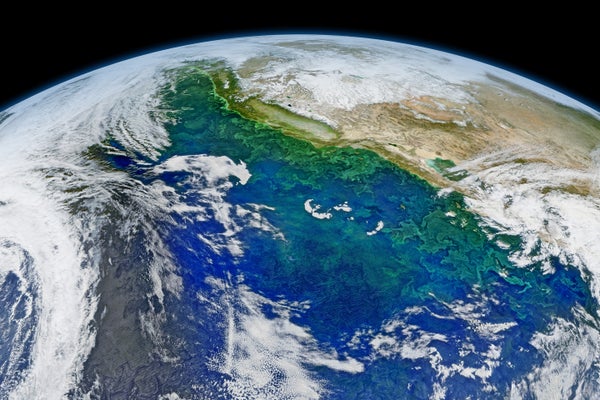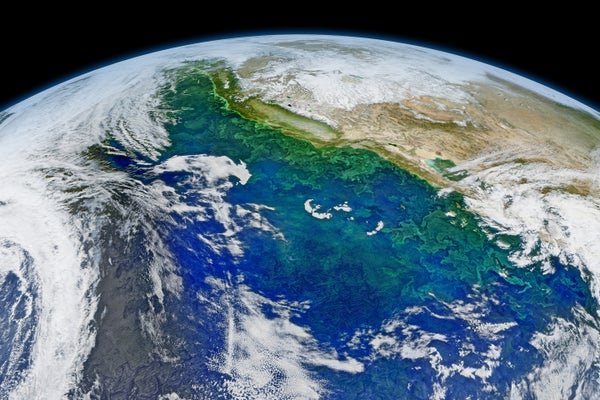September 12, 2024
4 min read
Scientists Will Engineer the Ocean to Absorb More Carbon Dioxide
A research consortium plans to revive geoengineering trials of the controversial iron fertilization technique to pull carbon dioxide from the air, despite public backlash

This February 8, 2016 composite image reveals the complex distribution of phytoplankton in one of Earth’s eastern boundary upwelling systems — the California Current.
NASA/Goddard/Suomin-NPP/VIIRS
Scientists plan to seed part of the Pacific Ocean with iron to trigger a surface bloom of phytoplankton that will hopefully suck carbon dioxide out of the air, reviving field trials of a geoengineering technique that has been taboo for more than a decade.
On Sept. 9, 23 academics from Exploring Ocean Iron Solutions (ExOIS), a not-for-profit, noncommercial consortium, laid out a program in Frontiers in Climate to assess iron fertilization. The researchers want to better quantify how much CO2 this technique could sequester in the deep sea and what impacts it might have on marine ecosystems. They hope to start trials across as much as 10,000 square kilometers of the northeastern Pacific Ocean as soon as 2026, says consortium member Ken Buesseler of the Woods Hole Oceanographic Institution.
The Intergovernmental Panel on Climate Change says the world will likely need to remove billions of metric tons of atmospheric CO2 to limit global warming to 1.5 degrees Celsius (2.7 degrees Fahrenheit), and Buesseler says that fertilization could be “one of those pieces in that puzzle.” The ocean already contains much more carbon than Earth’s plants, crops and soils, he says, and it has the capacity to hold far more. Spreading iron, he adds, can “speed up” the natural biological carbon pump by promoting greater phytoplankton growth.
On supporting science journalism
If you’re enjoying this article, consider supporting our award-winning journalism by subscribing. By purchasing a subscription you are helping to ensure the future of impactful stories about the discoveries and ideas shaping our world today.
During photosynthesis, phytoplankton consume CO2, sunlight and nutrients, including iron. But in many parts of the ocean, this element is rare. If some is delivered to these areas by windblown dust or volcanic ash—or by a ship deliberately pumping out an iron sulfate solution—a vast number of the microscopic organisms can quickly grow and multiply. When these creatures die or are eaten and excreted by larger ones, some of the carbon that they took up sinks to deep, slow-moving waters as “marine snow,” keeping the carbon out of the atmosphere for decades or centuries.
ExOIS is trying to raise $160 million for the entire program. As a start, the scientists have received a $2-million grant from the National Oceanic and Atmospheric Administration for computer modeling, and they are in talks with potential donors such as the Ocean Resilience and Climate Alliance, a philanthropic coalition funded by billionaire Michael Bloomberg and others.
ExOIS plans to apply to the U.S. Environmental Protection Agency for permission to conduct trials under the London Protocol, which in 2013 set an international ban on ocean iron fertilization for commercial purposes. The convention allows fertilization for research if it is monitored and doesn’t harm the environment.
Buesseler and others added iron to the ocean during a dozen experiments in the 1990s and 2000s. But a public backlash against tinkering with natural Earth systems arose in 2012, after American entrepreneur Russ George notoriously dumped 100 metric tons of iron dust off the coast of Canada, partly to bolster salmon fishing.
ExOIS promises detailed monitoring of the effects of its field studies, as well as improved computer modeling of the implications. The scientists will add a nonreactive tracer such as sulfur hexafluoride to the iron sulfate solution, a step that will help track the spread of the fertilized water as the iron sulfate slowly breaks down. They will measure CO2 concentrations using ships, floats and underwater drones. And they will check satellite images that can register increases in phytoplankton color at the ocean’s surface. The group is also promising more public engagement and consideration for environmental impacts than were involved in previous iron-spreading projects.
Effects could be varied and wide-ranging. In a 2009 experiment in the southwest Atlantic Ocean by German and Indian scientists, larger zooplankton ate the smaller phytoplankton—and little carbon actually reached the deep sea. In an experiment that was conducted in 2006 in the northeastern Pacific by researchers in the U.S. and Canada, toxic phytoplankton species flourished. This has raised fears that fertilization could create “dead zones” where rampant algal blooms would consume all the oxygen in the water, snuffing out other life. Phytoplankton blooms could also consume nutrients such as phosphorus and nitrogen that then wouldn’t be available for organisms elsewhere, a phenomenon known as “nutrient robbing.” In addition, scientists still know little about the deep-ocean ecosystems where the carbon is supposed to be stored. “Most likely [iron fertilization] will affect something that we don’t really understand yet,” says deep-sea expert Lisa Levin of the Scripps Institution of Oceanography, who is not involved in the ExOIS program.
Last year a computer modeling study done by British, American and French researchers found that adding one million to two million metric tons of iron into the ocean each year could draw down 45 billion metric tons of carbon by 2100. It would also rob nutrients from other sea life, however. Along with an estimated 15 percent reduction in marine biomass caused by warming, another 5 percent could be lost because of iron fertilization, particularly in fishing areas near the Atlantic, Pacific and Indian coasts. “I haven’t really seen [ExOIS] present a hypothesis of what’s wrong with previous work … that either makes the carbon yield higher or minimizes the negative consequences,” says Alessandro Tagliabue of the University of Liverpool in England, co-lead author of that study.
Buesseler argues that some difficult trade-offs such as this may be necessary. “It’s a small change in biology, relative to doing nothing and watching this planet boil,” he says.

